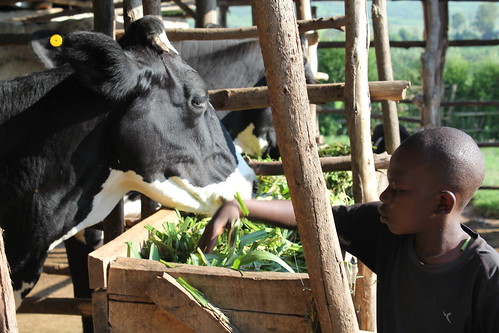A young East African feeds his family’s dairy cows (photo credit: EADD).
From 2008, the East Africa Dairy Development (EADD) project has been working in Kenya, Rwanda and Uganda with the aim of transforming the lives of 179,000 families (about 1 million people) by doubling household dairy income in 10 years through integrated interventions in dairy production, market access and knowledge application.
The project is funded by the Bill & Melinda Gates Foundation and implemented by Heifer International, African Breeders Services—Total Cattle Management, the International Livestock Research Institute (ILRI), TechnoServe and the World Agroforestry Centre.
With the first phase of the project ending in June 2013, two members of the project team—Isabelle Baltenweck, agricultural economist at ILRI, and Gerald Mutinda, the EADD regional manager in charge of dairy productivity, gender and youth—recently had the opportunity to take stock of some of the project’s key achievements during a ‘livestock live talk’ held 26 Jun 2013 at ILRI’s Nairobi campus.
Livestock live talk is a seminar series at ILRI that aims to address livestock-related issues, mobilize external as well as in-house expertise and audiences and engage the livestock community around interdisciplinary conversations that ask hard questions and seek to refine current research concepts and practices.
The talk began with a description of the project, its value chain approach, vision and objectives, and followed by an overview of its achievements and lessons learned.
The speakers then highlighted the project’s innovative ‘hub approach’ which was adopted to help overcome the challenges small-scale dairy farmers often face in accessing farm inputs such as feeds as well as animal breeding and health services.
The hub approach takes advantages of economies of scale and enables service providers to have a wider customer base, thereby making it more efficient for them to operate. Through the hub approach, farmers organize themselves into dairy farmer business associations that make it easier for individual farmers to access inputs and services as well as facilities for bulking and cooling of raw milk.
It was noted that the hubs should not be viewed as a ‘model’ per se, but rather as an approach that can be tailored and adapted to suit different regions and countries. For example, the project found that many hubs can be successful by providing milk bulking services alone while others can offer both milk bulking and cooling. For the second phase of the project, the hub approach planned for Tanzania is centred around the provision of inputs and services.
Another key learning point was the importance of ensuring that the due attention is given to gender aspects during the design and implementation of the project. The speakers admitted that key aspect was overlooked during the design of the first phase of the project. As a result, some key gender-based indicators were not properly tracked.
However, this oversight has been corrected and the team now has a comprehensive gender strategy in place to guide the project design for the second phase to ensure that gender mainstreaming is incorporated through gender analysis at various levels of the value chain as well as monitoring and evaluation of thematic gender-based studies.

